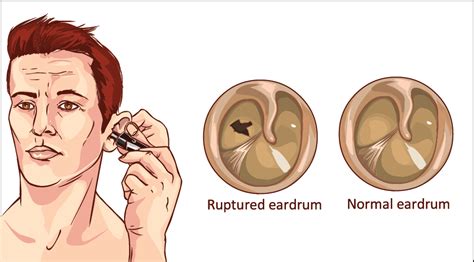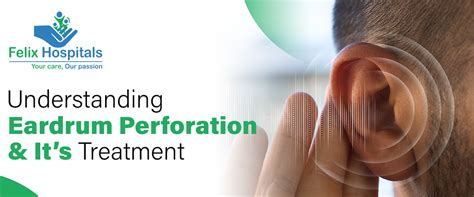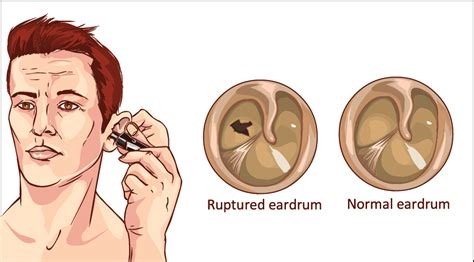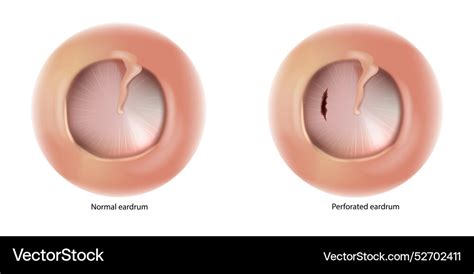Intro
Experience severe ear pain? A ruptured eardrum causes painful symptoms like hearing loss, vertigo, and discharge, requiring prompt treatment to alleviate eardrum perforation complications and promote healing.
The human ear is a complex and delicate organ, responsible for detecting sound waves and maintaining balance. One of the most critical components of the ear is the eardrum, a thin membrane that separates the outer ear from the middle ear. When the eardrum is damaged or perforated, it can lead to a range of painful symptoms and potentially serious complications. A ruptured eardrum, also known as a perforated eardrum or tympanic membrane perforation, is a common condition that affects millions of people worldwide. In this article, we will delve into the causes, symptoms, and treatment options for a ruptured eardrum, as well as explore the importance of seeking medical attention if you suspect you have suffered a perforated eardrum.
The eardrum plays a vital role in our ability to hear and maintain balance. When sound waves reach the eardrum, they cause it to vibrate, which in turn stimulates the tiny bones in the middle ear to transmit these vibrations to the inner ear. The inner ear then converts these vibrations into electrical signals that are sent to the brain, allowing us to perceive sound. However, when the eardrum is damaged, these vibrations are disrupted, leading to hearing loss, ear pain, and other symptoms. A ruptured eardrum can be caused by a variety of factors, including middle ear infections, trauma to the ear, Eustachian tube dysfunction, and exposure to loud noises.
A ruptured eardrum can cause a range of painful symptoms, including ear pain, hearing loss, and discharge from the ear. In some cases, a perforated eardrum can also lead to vertigo, tinnitus, and a feeling of fullness or pressure in the ear. If left untreated, a ruptured eardrum can lead to more serious complications, such as chronic ear infections, mastoiditis, and even permanent hearing loss. It is essential to seek medical attention if you suspect you have suffered a ruptured eardrum, as prompt treatment can help alleviate symptoms and prevent long-term damage.
Ruptured Eardrum Causes and Risk Factors

Ruptured Eardrum Symptoms and Diagnosis
A ruptured eardrum can cause a range of painful symptoms, including ear pain, hearing loss, and discharge from the ear. In some cases, a perforated eardrum can also lead to vertigo, tinnitus, and a feeling of fullness or pressure in the ear. To diagnose a ruptured eardrum, a doctor will typically perform a physical examination and take a medical history. They may also use an otoscope to visualize the eardrum and check for any signs of perforation. In some cases, a doctor may also order a hearing test or a CT scan to rule out other conditions and confirm the diagnosis.Ruptured Eardrum Treatment Options

Ruptured Eardrum Prevention and Complications
Preventing a ruptured eardrum requires taking steps to protect the ears from injury and infection. This can include avoiding loud noises, wearing ear protection when engaging in loud activities, and practicing good ear hygiene. It is also essential to seek medical attention if you suspect you have suffered a ruptured eardrum, as prompt treatment can help alleviate symptoms and prevent long-term damage. If left untreated, a ruptured eardrum can lead to more serious complications, such as chronic ear infections, mastoiditis, and even permanent hearing loss.Ruptured Eardrum Recovery and Outlook

Ruptured Eardrum Home Remedies and Self-Care
There are several home remedies and self-care strategies that can help alleviate the symptoms of a ruptured eardrum. These can include applying a warm compress to the affected ear, taking over-the-counter pain medication, and practicing good ear hygiene. It is also essential to avoid inserting objects into the ear, such as cotton swabs, and to avoid blowing your nose or sneezing with your mouth closed. By taking these steps, you can help promote healing and reduce the risk of further complications.Ruptured Eardrum Frequently Asked Questions

What are the symptoms of a ruptured eardrum?
+The symptoms of a ruptured eardrum can include ear pain, hearing loss, and discharge from the ear. In some cases, a perforated eardrum can also lead to vertigo, tinnitus, and a feeling of fullness or pressure in the ear.
How is a ruptured eardrum diagnosed?
+A ruptured eardrum is typically diagnosed with a physical examination and medical history. A doctor may also use an otoscope to visualize the eardrum and check for any signs of perforation. In some cases, a doctor may also order a hearing test or a CT scan to rule out other conditions and confirm the diagnosis.
What are the treatment options for a ruptured eardrum?
+Treatment for a ruptured eardrum typically depends on the underlying cause and severity of the condition. In some cases, a ruptured eardrum may heal on its own with rest and antibiotics. However, in more severe cases, surgery may be necessary to repair the eardrum and restore hearing.
Ruptured Eardrum Final Thoughts

